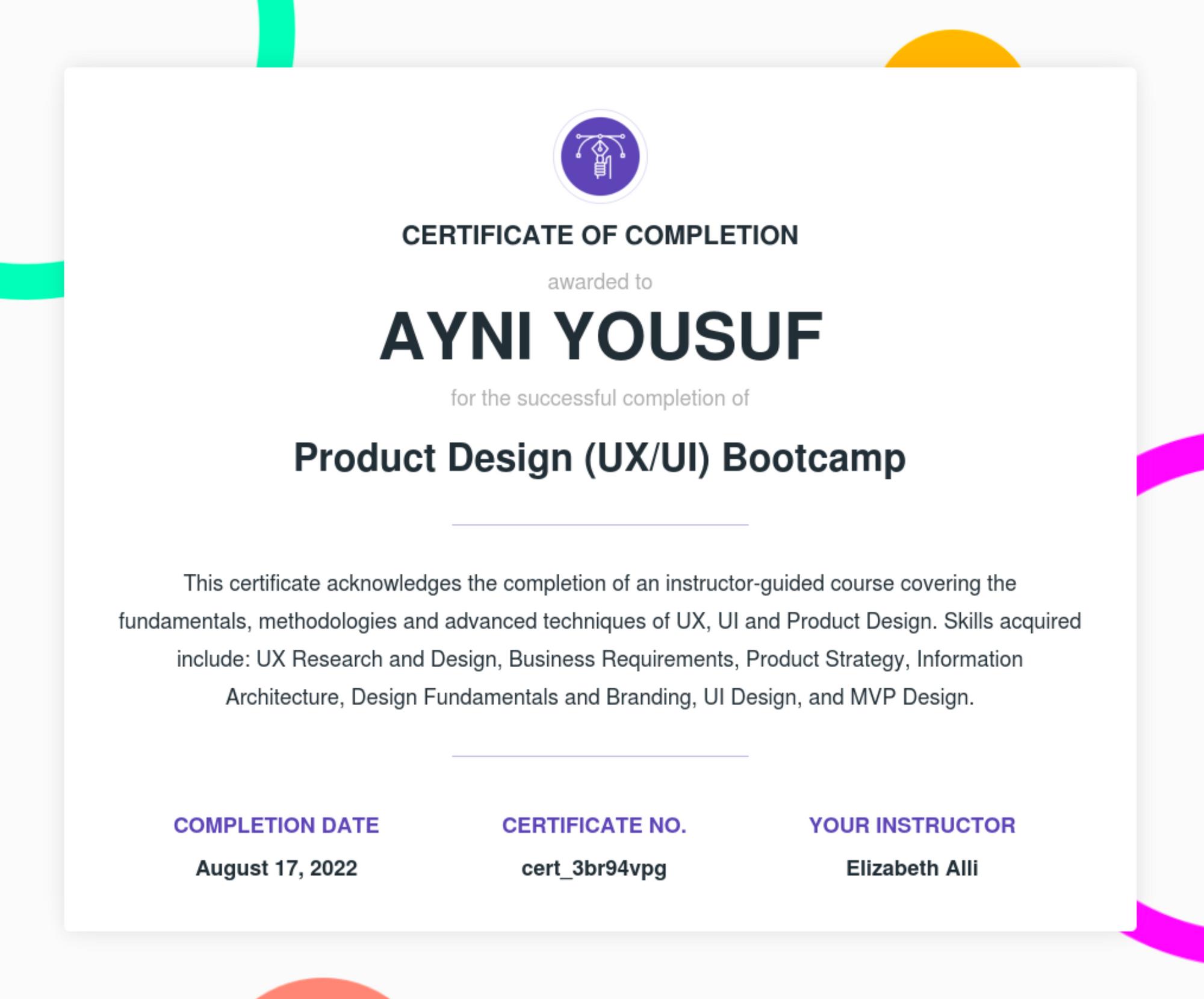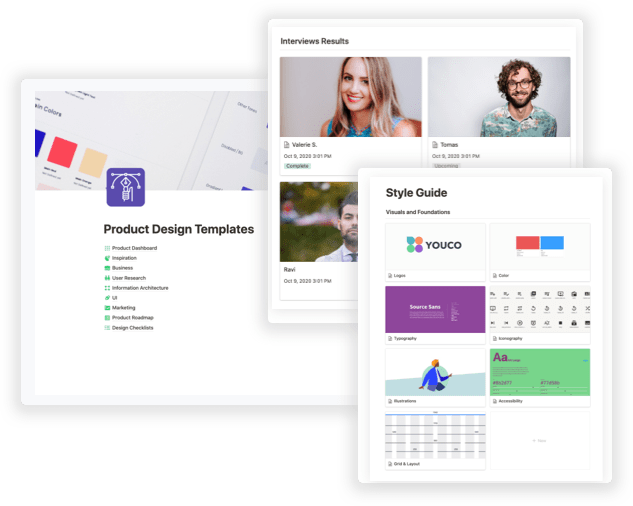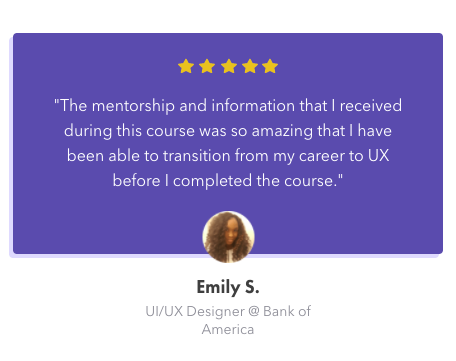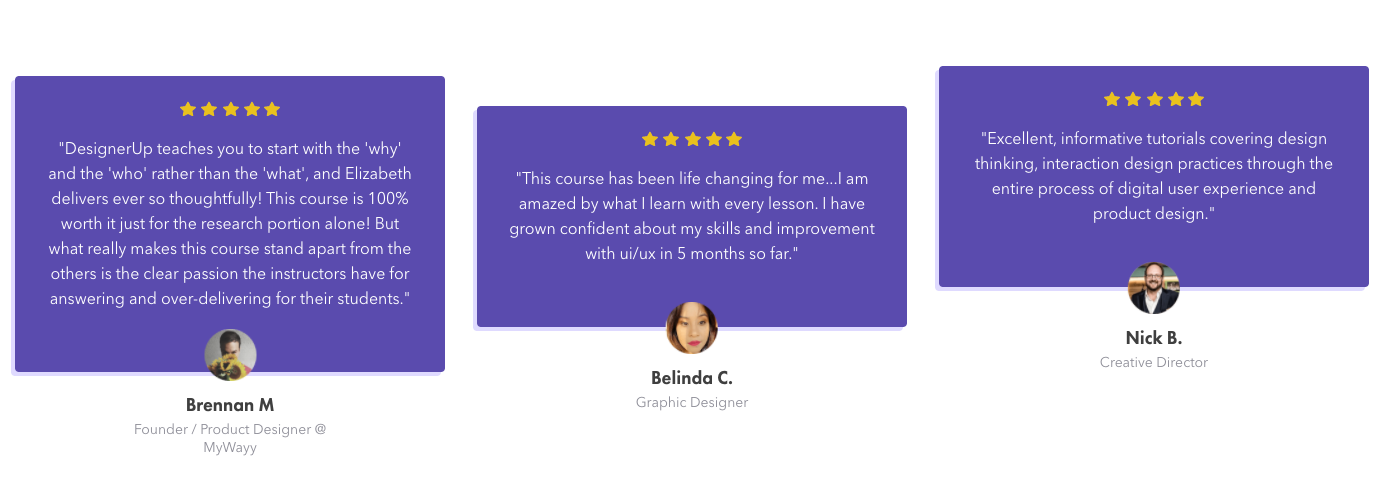So, you’ve stumbled on UX, UI or Product Design and it looks like a great career option that sounds too good to be true and doesn’t require a degree. A path that seems to make sense of all of your disparate skills and career explorations and the potential to make a positive impact through problem-solving, creativity, and technology.
Perhaps, you are new to all of this, or maybe you’re already in the tech world yearning to push yourself to new heights and expand into new disciplines of product design.
It’s a wonderful, lucrative, and competitive time to become a product or UX/UI designer and the one thing that holds true for all of us is the need for quality, ongoing design education.
But when it comes to how to get that education, you might be wondering what your options are and how to decide.
As a professional product designer and teacher for over 14 years, I’ve watched many aspiring designers wrestle with this question. It’s a very personal decision, one with many pros and cons, features, and outcomes to weigh.
“It’s a very personal decision, one with many pros and cons, features, and outcomes to weigh.”
To make the task more manageable, I’ve outlined a filtering process to give you a better understanding of the landscape of online, digital product design education; UI/UI and Product Design courses, programs, and Bootcamps and to help you make a more informed decision about what’s right for you.
Filter 1. Choose a design career path

The first step starts with you.
Do you want to climb the ladder and move through the corporate structure, do you build a ladder; joining a fast-moving startup or do you want to become the ladder; creating your own freelancing business, products, or agency?
Do you want to climb the ladder, build the ladder or become the ladder?
While the core skills of product design are universal; the journey is individual. The processes, methodologies, day-to-day work, and approach to job applications that you’ll need to apply will be different depending on the type of career path you choose. So you’ll want to choose a product design course or Bootcamp that prepares you adequately with the core hard and soft skills as well as the specific strategies, techniques, and marketing positioning that will help you land the type of work you want.
Keep in mind that most large Bootcamps prepare you to enter the hiring cycle and become an IC-level designer at a corporation but don’t prepare you as well for the possibility of alternative career paths/ladders.
If you aren’t sure what you want your career path to be, choose a product design course that doesn’t lock you into just one. Want to work for a company and then freelance for a while before starting an agency? Make sure that no matter what career pivots happen in their future you are well prepared.
Some self-assessment questions to ask:
- Where do you want to work?
- What is your big-picture career goal?
- Where are you starting from?
- What are your transferable skills?
- What areas do you think you need to level up?
Filter 2: Choose a design course scope:

Compare apples to apples not apples to oranges.
The precision of comparison when choosing a program is important. Comparing a short course in UX design is not the same as comparing a long course in Product Design — avoiding apples to oranges is the second filter that will help you narrow down your design program options.
So decide if you want a well-rounded, multidisciplinary education in the foundations and overall processes of product design or if you want to cherry-pick and level up specific skills or disciplines; such as UI or Usability Testing for example.
As a beginner, a well-rounded foundation is recommended to understand the larger theoretical concepts as well as to get more granular practice developing your skills, techniques and processes, and workflows.
Even with seasoned designers, my observation has been, that if you’re feeling stuck where you are and haven’t already had formal product design training, learned the product design process from start to finish, or built a product yourself, there is a high likelihood that you might have some blind spots or foundational principles missing from your purview that could be holding you back from progressing in your career.
“If you’re feeling stuck where you are, there is a high likelihood that you might have some blind spots or foundational principles missing from your purview that might be holding you back from progressing in your design career.” — Tweet this
Many curriculums go into varying depth and breadth of material; some cover just UX, some that go deep into UI, but very few cover holistic product design (UI/UX) along with business strategy and soft skills.
Despite ‘product design’ being the fastest-growing field and ‘product designer’ being the fastest-growing and highest-paying job title in the field, the education industry is still playing catch up, with most courses and programs focused primarily on the ‘User’ side of things and leaving students ill-equipped in the areas of business acumen, product strategy and soft skills; all things that are becoming increasingly important to be able to get buy-in from stakeholders, increase the design maturity of an organization and make an impact with the work you are doing.
Filter 3: Choose a design program type

Learn about the main categories of online design education.
There are many different types of programs, Bootcamps, and courses to choose from, but they all fall into one of the following categories that will dictate the cadence and experience of the learning.
Traditional Academia
While some accredited university-level programs now offer traditional online degrees or diplomas in User Experience design the good news is that this is not a prerequisite for becoming a professional product or UI/UX designer. Unlike many high-paying professions, our value as a designer isn’t dictated by the institution that we attend. Our merit as a designer comes from how elegantly and convincingly we can solve complex user problems.
However, there are certain circumstances in which it might be beneficial or desirable to earn a formally recognized or accredited diploma or degree, such as when it is required for a specific position, if you plan to teach at high-level institutions or if required for you to obtain a certain work permit or visas.
Self-directed learning
As designers, we are in a perpetual state of self-learning and with all of the wonderful free resources and content online it is possible to gain a lot of valuable information on your own. But your self-education will only be as good as the effort and work that you put into curating, organizing, and essentially creating a program and a routine for yourself. So here are some important things that you’ll need to focus on if you decide to self-learn:
- Effectively curate existing content
- Cross-referencing and verifying sources
- Prioritizing tasks, effort, and energy
- Organizing and managing your work,
- Conducting your own design challenges, exercises, or joining hack-a-thons
- Managing your time well
- Evaluating your own progress
- Being proactive and self-motivated
- Reaching out for help and support from others in the design community
For those ambitious autodidacts, we’ve created lots of free content on our website, on our YouTube channel and also offer an entire workspace built on Notion specifically for UX/UI and product designers that is great for self-learners or and those working on real projects to manage all of the areas required to design effective digital products. We also have some invaluable free UI and UX checklists as a reference and guide to help keep you on track.
Depending on whether you are self-learning with free content or paid content there are a few things to consider:
Free content
Be aware that ‘free design content’ is not the same as a ‘free design education’. Most of the free content that does surface in your searches is designed to beat the search engine algorithms or to be lead magnets, not necessarily to maximize the quality or effectiveness of the content. If you do choose this route, you’ll need to be very proactive and intentional about the sources you choose to learn from and their intention and purpose. Consider the time it will take to curate quality sources and cross-reference their effectiveness.
Paid content
There are low-cost paid options that are great for those wanting more focused, in-depth content, however, don’t expect an entirely cohesive or linear process and do expect unpredictability when it comes to quality of content, the distillation of information, and depth and breadth of knowledge being shared.
Self-learning (free or paid ) is a great option for those that are just getting a feel for the field and want an overview of disciplines and are looking for more generic answers to broader questions, or for those that are prepared to put in the time and effort into curating and creating their own learning experience.
On-demand (evergreen), self-guided
Evergreen courses contain a curriculum of on-demand lessons that you can access at any time and complete at your own pace. They do not normally provide any direct 1:1 interaction with the course instructor, teacher, mentors, or peers, though there may an add-on option for mentorship or a public community aspect.
DesignerUp’s Product Design (UX/UI) Course is one such option and is perfect for those that want to get a good overview of skills, disciplines, and deliverables in a cohesive structure way or cherry-pick specific content or concepts as you need to when working with others. When choosing an evergreen, on-demand course, make sure that the content is kept up-to-date and that there are additional resources and downloadables provided.
Cohort-Based Course, (CBC)
Many Bootcamps put a hefty price tag on the cohort-based experience which requires students to move through the program at the same time with their peers while guided to some degree by a mentor. This is a good option for those that feel they need more accountability, guidance and want to be pushed through a hard start and stop date. These are best suited to individuals who have ample time to dedicate part-time or full-time hours and can maintain a regular meeting schedule with their mentors. Keep in mind that large CBCs are built for scale and tend to offer cookie-cutter assignments and portfolio projects with little to no customization. Because of the lack of personalization, schools leave students having to do a lot of extra work to supplement their learning and job hunting experience.
CBC on-demand
On-demand, cohort-based courses allow you to watch pre-recorded curriculum lessons and do assignments and submit them for feedback, which is often provided by a mentor that is in the same field.
CBC Live
These workshop-style courses are similar to the on-demand CBC, but the teachings are transmitted live in a virtual classroom-type atmosphere (like Zoom) rather than pre-recorded for you. Often the lessons are worked on in a group setting. These are designed to be very high-energy, fast-paced and high-pressure. Think of it as CrossFit for designers. Good for those who are on a hiatus or plan to time block a set number of weeks to intensive, immersive learning.
Hybrid, Personalized
Is it possible to have it all? While the options for product design courses and programs like this are few and far between. DesignerUp offers a self-paced, instructor-guided Bootcamp program that is both on-demand and completely personalized to each student.

A program with equal parts UI, UX, and Business and Product Strategy, as well as soft skills training like ours is hard to find, but building acumen in each of those areas can give you the edge against the competition and make you a more valuable designer in the workplace.
Programs such as this can provide the rigorous curriculum of a CBC Bootcamp with the ability to access evergreen on-demand lessons on your own time while still having the fully immersive and interactive experience of 1:1 instruction and a vibrant, engaged, and supportive community of peers.
Filter 4: Match the program with your needs and situation

Now that you understand your needs and what types of programs are available, it’s time to find the perfect fit by defining these things:
Your learning style
At a baseline, the program you choose should have a good balance of visual, auditory, and textual content or lean more heavily towards your own personal preference (i.e. choose a video-based course if you prefer watching lessons over reading long-form essays). DesignerUp’s Product Design Course was created by a trained teacher and designed to maximize how students absorb, retain and retrieve the information they take in and to satisfy the learning styles of all types of students.
Time commitment
Understand how much time you want to spend learning each day, each week, and get a realistic idea of what the program will require. It’s also good to have an idea of how soon you would like to start applying for jobs. If you are applying for positions at large companies understand these hiring cycles so that you can be prepared to apply at the right time. For maximum control over your time, look for a self-paced program so that you can move through it as slow or as fast as you’d like.
Finances
Cost is a big deciding factor for many students and unfortunately, cost doesn’t always equate to quality. Large bootcamps with outside funding optimize for scale, not personalization; moving students through a one-size-fits-all approach, so keep in mind that you will have to do a lot on your own to supplement the creation of your portfolio and the outcome of your education. Very small product design or UX/UI courses usually have to charge a large amount for their 1:1 time to make it worth it. Our mission at DesignerUp is to make high-quality design education more affordable, by running a sustainable business model so that more diverse candidates from all walks of life can start careers in product design.
Certificate and skills verification
Does the program offer some sort of verification of the learning that you’ve done and the skills you’ve acquired? Some programs may be accredited and others might not be, but regardless a certificate of completion and reference letter from your instructor can be useful to verify the type of training you received and bolster your resume during the job application process.

Additional support
Will you need to purchase design software? Do you need a subscription to tools like a note-taking app or project management software? What about icon packs, UI kits, and other design resources? Ask about whether this will be out of your pocket or theirs.

Is the program ‘design software agnostic’ or does it require you to use a specific design app like Adobe XD, Sketch or Figma? While most design tools are very similar, it's best to not be limited to using any one program. Being able to choose your tool lessens the learning curve by allowing you to work with through the program using whatever tool feels more intuitive to you and matches your mental model.
Filter 5: Red flags:

When seeking out a program there are a final few things to consider that can lead to trouble and loss of time and money if you’re not careful.
Courses that don’t teach you the business of design
Bootcamps, courses, and programs with names like UX academy, Learn UI, Learn UX, UX 101, UX and UX immersive, and other courses that don’t have ‘Product Design’ in the title oftentimes focus mainly on the experience of the user, overlooking topics on business models, performance indicators, clients requirements, not to mention soft skills like communication, empathy practices and how to get buy-in from stakeholders and present your work. However, these are a huge differentiating factors that employers and clients look for when hiring and are crucial to progressing in your career. Look for a program that helps you practice and cultivate a well-rounded skillset and mindset.
Job Guarantees and Job Placement
Some large Bootcamps and courses like to lure you in with the promise of a job waiting for you at the end, but what you might not know is what is in the fine print. Most job guarantees are easily voided if you miss even one thing out of an incredibly convoluted and long list of requirements and many restrict placements to only certain cities. Some companies pre-negotiate expensive job placement agreements with firms and then pass the cost onto the students. Some even hire their own students to inflate their outcome numbers.

Aside from that, you don’t want to land a job just for the sake of landing a job or to check off an outcome box for your Bootcamp. Aim to grow into a high-valued designer that can go after your dream roles, provide business value to organizations, and become a design leader and you won’t need a job guarantee.
Beware the Income Share Agreement
An alternative to a student loan, an income share agreement (ISA) allows a student to defer paying for their education after they’ve landed a job. How much you’ll pay is based on a pre-determined percentage amount that will be taken out of your salary over time and paid back to the school. While this may sound like a good idea, there are downsides to consider:
“Because ISA payments are based on your income, it’s impossible to know how much you’ll pay on a monthly basis, or in total, compared to traditional student loans. That’s because you don’t know how much your salary will be” - Forbes
If you are interested in an ISA, make sure to do your research and read the fine print and terms of services carefully to determine if the agreement is favorable to you.
Opting for a simple payment plan, financial assistance, or a less expensive program that prioritizes equity and accessibility are good alternatives to an ISA.
No Program Customization
No two students are alike so why should your education be? It’s difficult for large bootcamps to maintain customization at scale, as a result you’ll find a less personal approach and more cookie-cutter portfolio projects. In today’s competitive market recruiters can spot most large Bootcamp portfolios a mile away, so beware that you will have to go the extra mile to do your own projects and ground-work when you are done if you want to stand out. Look for a program that helps you create unique projects and a magnetic portfolio.
No Project Management System
A completely overlooked, yet supremely important aspect of one’s learning journey and the place you will spend the most time is in your note-taking app, organizing your thoughts, saving and analyzing your research, and housing your work in progress So make sure that there is a system or plan in place to help you manage this.
Curated Not Created Curriculums
Some of the biggest and most popular Bootcamps charge a premium for content that you could actually find for free, online yourself. There is a benefit to having some of the best design content collected and organized for you, but be careful of curriculum content that is only curated and not created and not delivered in a cumulative and cohesive way.
Not Created or Taught By an Instructor
Most bootcamps, courses, and programs are either created by business people or created by designers. While it’s important to have mentors and be exposed to the help of professionals in the field, a trained instructor or teacher of the curriculum is an invaluable resource that will make a huge impact on how the content is created and delivered and can save you a lot of time and frustration during the learning process. It’s the difference between a baseball player explaining how to throw a fastball vs having a coach look at your throw, notice that you pull to the left, and adjusting your arm for the perfect pitch.
So in summary:
✅ Filter 1. Choose a design career path
✅ Filter 2: Choose a design program scope
✅ Filter 3: Choose a design program type
✅ Filter 4: Match the program with your needs and situation
✅ Filter 5: Beware of red flags
Choosing a product design course, UX/UI Bootcamp or program that's right for you can be quite the challenge. But armed with this knowledge and actionable filtering process, we hope that it makes it easier to decide which direction you want to go in and helps you narrow down your options.

One of the best things you can do in the end is to do your research and trust your gut and your instincts. Talk to someone that runs the program, ask all of your questions and let the facts and your intuition guide you to the course that is best for you and if you get lost along the way just remember to ask:
"What is the absolute minimum you need to know to take the next step?" - Taigo Forte
The most important thing is that you take action and get started!
Our very best to you on your learning journey!
